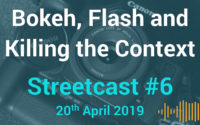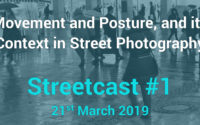Scene appreciation, leaving out and outside in… – Screencast #4 – 6th April 2019
The one thing I have noticed about my most satisfying images is that I had a conscious thought process at the time I took them. The value of the image was not the effort I put in; but the effort I put in made a difference to clearly representing what I wanted to show.
In street there seems to be a correlation between having enough in the image to complete the scene. Whilst at the same time positioning ourselves to ensure erroneous “bits” are left out or pushed to the side.
The more street photography I have done, the more I have learned to leave things out. A cigarette end on the pavement, lamp post or street sign and similar things, can all destroy an image if they are not part of the message. We often see this with snap shots, family holiday pictures or a picture of a landmark. And I have been just as guilty as anybody else of not paying attention to the whole scene.
Documentaries
I remember seeing a documentary from a model photographer, talking to his assistant. There was a scene and the photographer was asking the assistant what was wrong. Like me at the time, the assistant was scrabbling in the mind to work out what it could be.
It was simply a very small part of something white that dominated the scene and drew the eye away from the models. They removed it from the setup.
Now obviously to remain true to street photography we need to be candid and not influence the contents of the scene. We can’t moving things. At the same time though getting into position and moving our “altitude” can be used to achieve the same effect.
Bang bang..
Some time ago I did a video on the film “The Bang Bang Club” and what I learnt from it. I got my copy free with a magazine, but I have seen copies on Youtube. One aspect mentioned was “working the scene” and until this film I didn’t understand what that meant in practice.
So I thought I would share how I interpreted it and what I do.
In the film a photographer, photojournalist, was confronted with an angry crowd with weapons and heated tempers. The way the film summarised the point was that he “worked from the outside in”.
This is good advice. At the beginning we see the whole scene, we start to get an appreciation for the elements and the cameos that exist.
We go closer and start to isolate the individual interactions between groups and their surroundings. By the time we get in really close we have had time and give attention to the parts. As a result we are better able to resolve the target opportunities.
Of course some of our work is opportunistic and we are ill prepared and must make do with our position if the fleeting moment is to be captured at all.
Large scenes and small details
But at the same time walking into a town square we can take the time to look at the various groups and activities before we take the camera to the eye.
Perhaps there is a juggler with kids watching on, people sitting on steps eating sandwiches or checking maps, cafes with waiters weaving their hips between tightly crammed tables and so on.
People engrossed in their own activities are both interesting as subjects and not interested in you. Two things that are a good beginning for a chance at getting a good street moment…
So next time you are “walking the streets” perhaps take the time to just look at the whole space and not just the next 5-10 meters. Starting in large spaces is good. And a cafe in a square is a great place to sit, leave the camera down and just look at the people, groups and activities that are going on. Take the time to appreciate the outside and then work your way in. Equally once you have selected your scene don’t forget to check the minute detail too.



